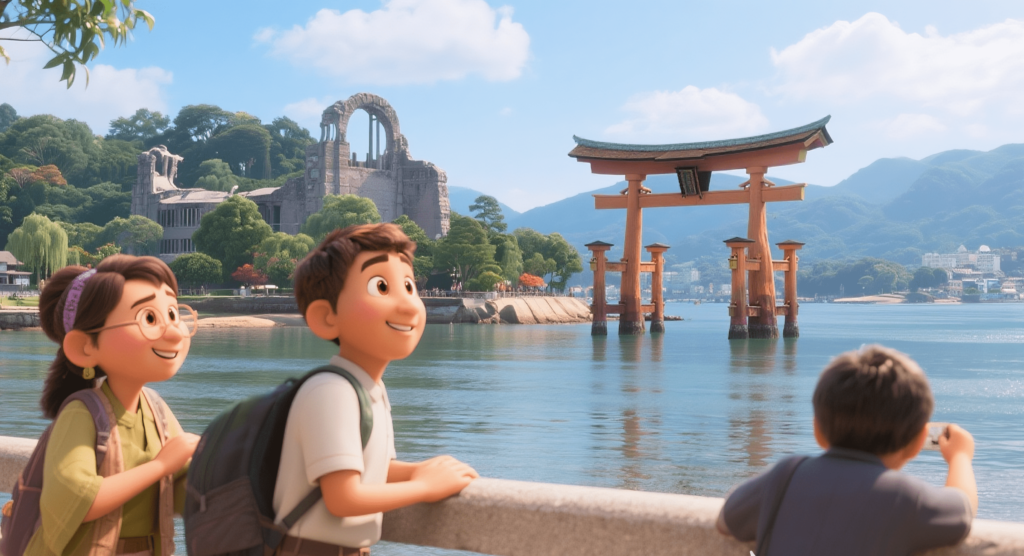Hiroshima and Miyajima, two iconic destinations in Japan, offer visitors a profound journey through history, culture, and natural beauty.

Introduction:
While Hiroshima bears the scars of its tragic past, it has emerged as a beacon of peace and resilience. Miyajima, on the other hand, enchants travelers with its serene landscapes and sacred sites. Together, these destinations provide a glimpse into Japan’s rich heritage and the enduring spirit of its people. Join us as we embark on a journey through Hiroshima and Miyajima, where history and beauty intertwine to create an unforgettable experience.
- Hiroshima: A City of Peace:
Hiroshima’s name is synonymous with tragedy, yet the city has risen from the ashes to become a symbol of peace and reconciliation. At the heart of Hiroshima lies the Peace Memorial Park, a poignant reminder of the devastating impact of the atomic bomb that was dropped on the city during World War II. Here, visitors can pay their respects at the Hiroshima Peace Memorial Museum, which houses artifacts, testimonials, and exhibits that document the events of that fateful day and advocate for a world free of nuclear weapons. The park also features the iconic Atomic Bomb Dome, a UNESCO World Heritage site and a haunting symbol of Hiroshima’s resilience in the face of adversity.
2. Miyajima: The Island of Gods:
Just a short ferry ride from Hiroshima lies Miyajima, an enchanting island known for its breathtaking beauty and sacred sites. Miyajima’s most iconic landmark is the Itsukushima Shrine, a UNESCO World Heritage site famous for its majestic torii gate, which appears to float on the water at high tide. Visitors can explore the shrine’s honden (main hall), pagoda, and surrounding grounds, which are home to lush forests, tranquil ponds, and resident deer that roam freely throughout the island. For panoramic views of Miyajima and the surrounding Seto Inland Sea, travelers can take a scenic cable car ride to the summit of Mount Misen, the island’s highest peak.
3. Honoring the Past:
Despite the tragedies that have befallen Hiroshima and Miyajima, both destinations are imbued with a sense of resilience and hope. Visitors are encouraged to reflect on the past, pay their respects to the victims, and honor the enduring spirit of the Japanese people. In Hiroshima, the Hiroshima National Peace Memorial Hall for the Atomic Bomb Victims offers a place for quiet contemplation and remembrance, while in Miyajima, the tranquil atmosphere of the Itsukushima Shrine provides a sense of serenity and reverence.
- Embracing Natural Beauty:
Beyond their historical and cultural significance, Hiroshima and Miyajima also boast stunning natural landscapes that are worth exploring. In Hiroshima, travelers can take a leisurely stroll along the banks of the Ota River, visit the scenic Shukkeien Garden, or hike to the top of Mount Hijiyama for panoramic views of the city. In Miyajima, visitors can relax on the island’s pristine beaches, take a scenic boat cruise around the coastline, or embark on a nature hike through the lush forests of Mount Misen.
Conclusion:
Hiroshima and Miyajima offer visitors a profound journey through history, culture, and natural beauty. From the solemn reminders of Hiroshima’s tragic past to the serene landscapes and sacred sites of Miyajima, these destinations provide a glimpse into Japan’s rich heritage and the resilience of its people. Whether paying tribute to the past, embracing the natural beauty of the present, or simply finding solace in the tranquil surroundings, a visit to Hiroshima and Miyajima is sure to leave a lasting impression on travelers and inspire a deeper appreciation for the resilience and spirit of Japan.






